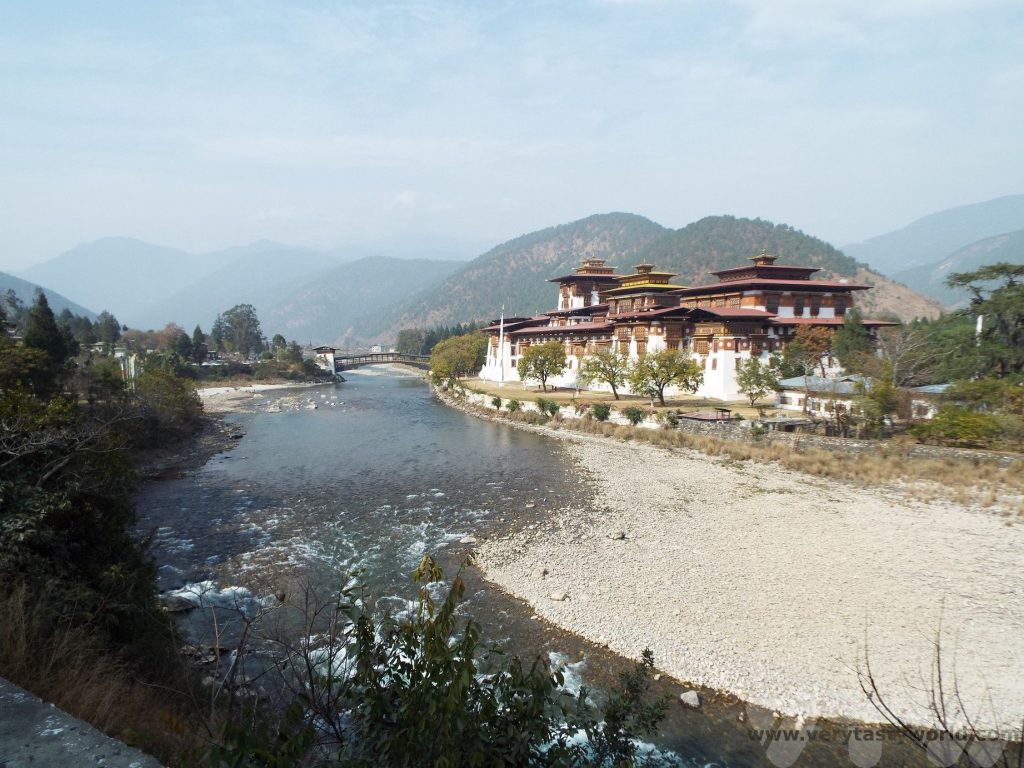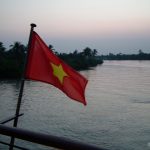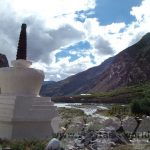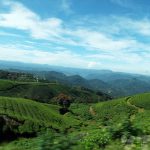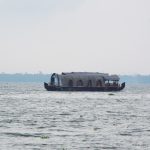Home » Posts tagged 'trekking'
Tag Archives: trekking
A Guide To The Bhutan Tiger’s Nest Trek
One of the highlights of a visit to the delightful Himalayan kingdom of Bhutan is a hike to the Tiger’s Nest, a monastery that clings dramatically to a cliff some 900m above the Paro Valley. Here is our guide for what to expect on the Bhutan Tiger’s Nest trek, a hike which is, quite literally, breathtaking.
Travelling in Bhutan is a very different experience to most other journeys. It is standard practice to visit Bhutan with a driver and guide accompanying you, as independent travel is not encouraged in this country. Our lovely guide Dawa accompanied us to the Tiger’s Nest.
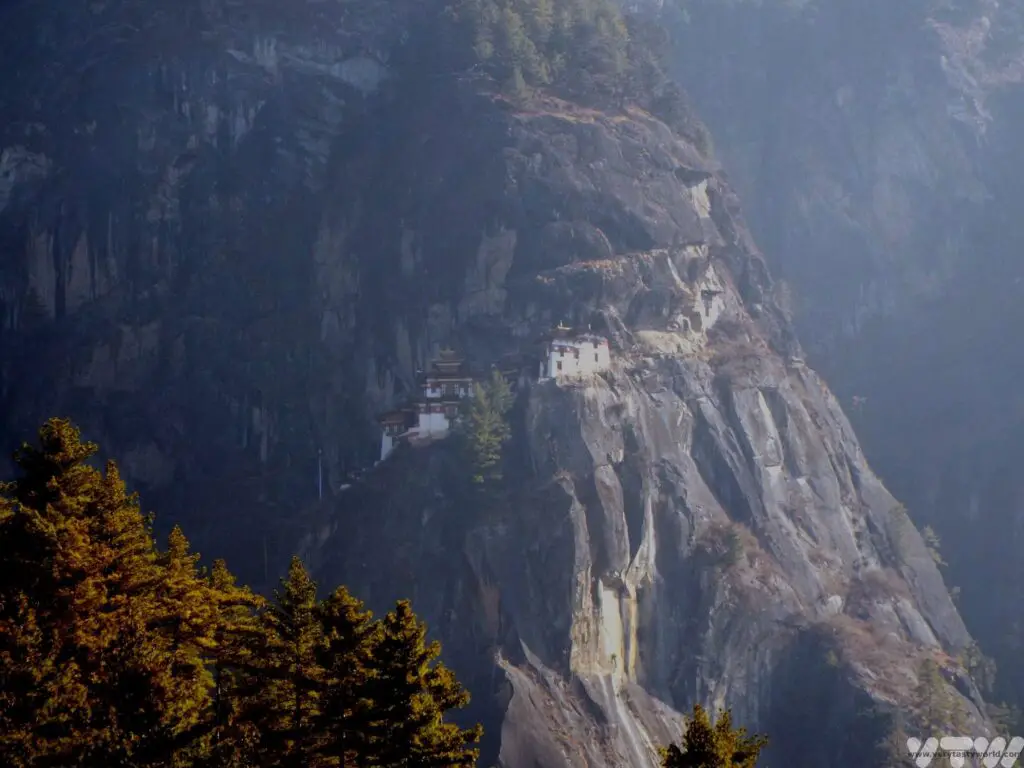
Paro is probably the flattest region that we visited within mountainous Bhutan and is the city where the country’s international airport is located. The flight in, as the plane weaves its way through the spectacular Himalayas, is an experience in itself. We flew from Nepal, passing Mount Everest on the way. (Top tip – ask for seats on the left side of the plane when checking in at Kathmandu airport.) But the landscape changes dramatically just outside the city as the mountains tower above the river, Paro Chu. Tiger’s Nest is located around 10km north of Paro.
The Legend of the Tiger’s Nest
Tiger’s Nest, known as Paro Taktsang, became a holy place in the 9th century. There is a legend that Guru Rinpoche (Padmasambhava) flew to this location from Singye Dzong on the back of a tigress and meditated inside the cave on the mountainside for several years. Guru Rinpoche brought Buddhism to Bhutan and is considered to be the most important saint in the country. There is a different legend that the wife of an emperor transformed into a tigress and carried Rinpoche on her back from Tibet. It is thought that the place became holy following the Guru’s meditation when he emerged in eight incarnated forms. A monastery was constructed around the caves in 1692.
Bhutan Tiger’s Nest Trek – The Overall Route
Visiting the Tiger’s Nest is one of the most popular activities in the region. We arrived early in order to get ahead of the crowds. When you arrive you will see that there are a number of mules available for hire. They can take you halfway up the route to the cafeteria, you cannot complete the whole route riding a mule. We don’t like using animals to transport us and we love walking, so chose not to ride. Also we wanted the satisfaction of hiking the whole way!
The photo – taken for posterity from the car park – shows the Tiger’s Nest. Can you see it?
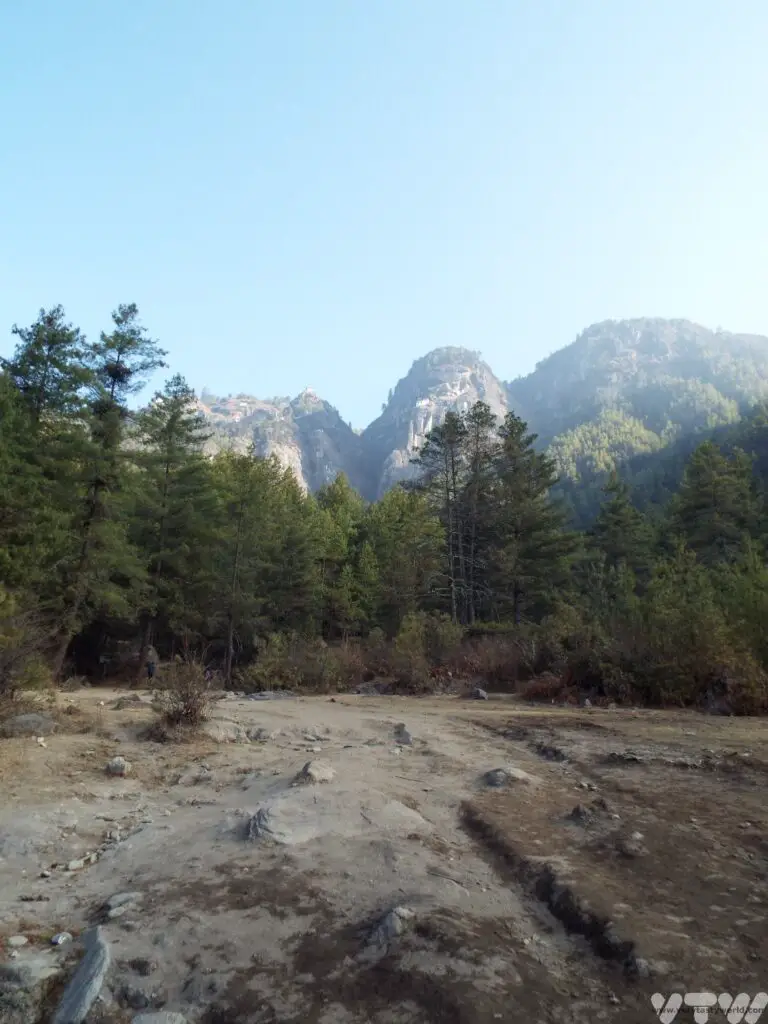
Here’s a photo with an arrow to show that it is waaaaaaay in the distance, clinging to the cliff face. It looked like a long way up. It was. But don’t worry, the route isn’t as direct as it looks – no actual climbing required!
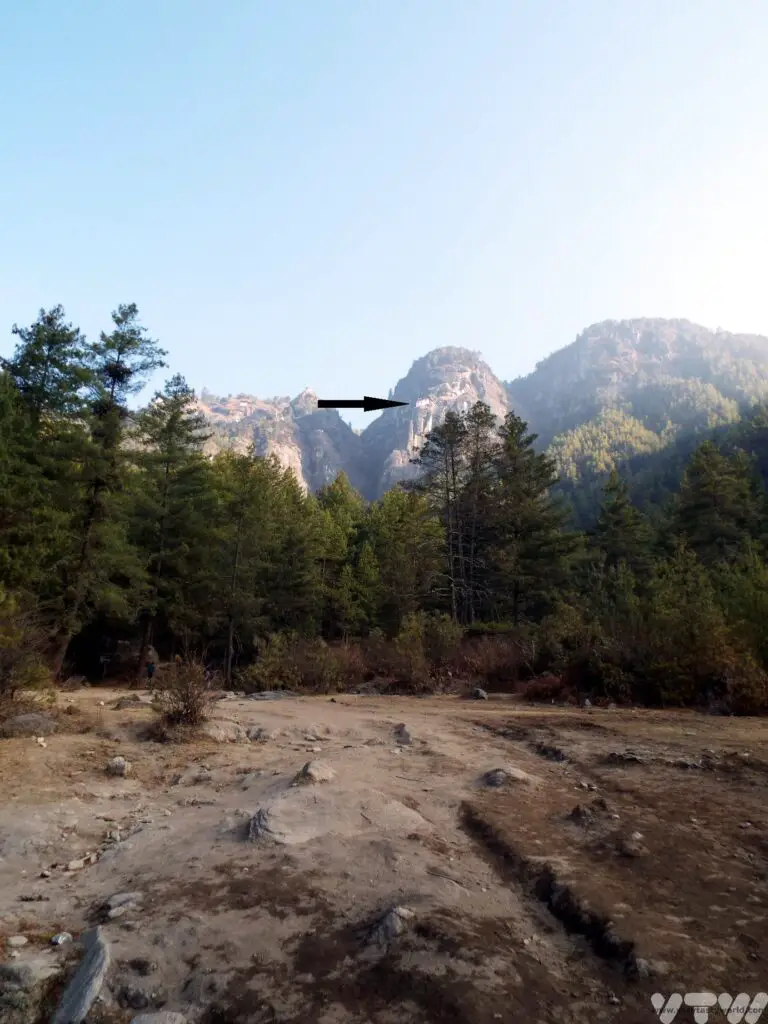
Walk To The Halfway Point
The majority of the Tiger’s Nest trek takes place along the adjacent hillside. The walk up to the halfway point isn’t particularly steep – just a consistent upward incline through the woodland on a sandy, occasionally rocky path.
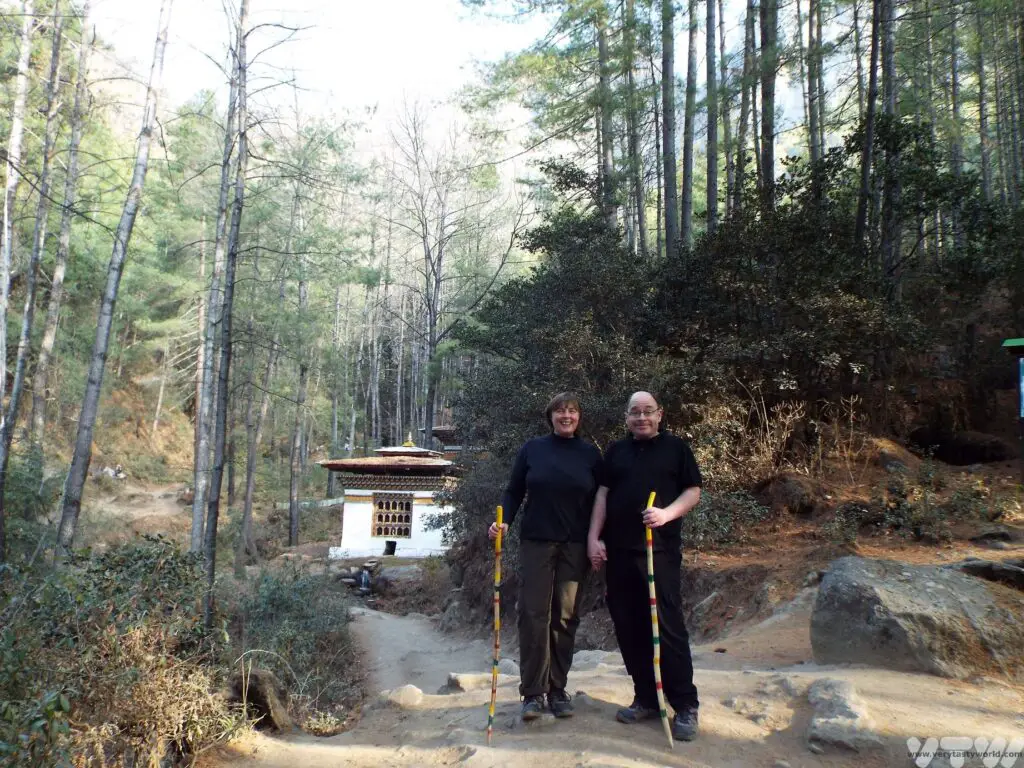
There is a cafeteria at the halfway point where you can get refreshments and use the bathroom if needed. This is as far as the mules will carry anyone. It will also be the last opportunity to use the toilet until you return to this area. The photo below shows the cafeteria from the top viewpoint.
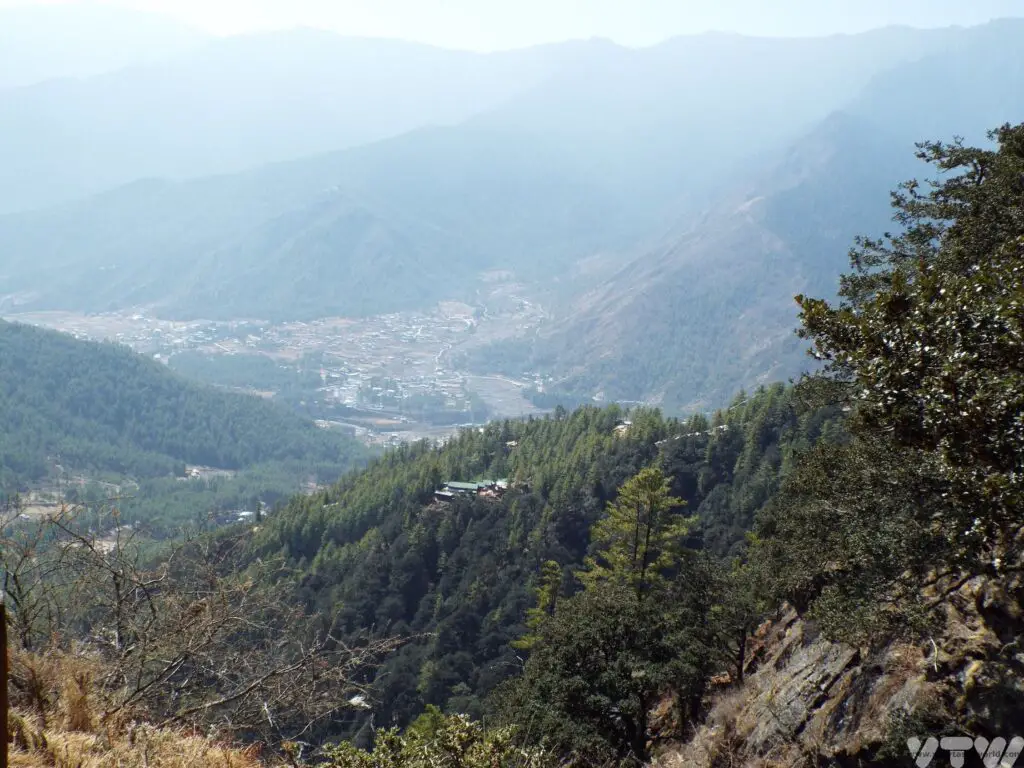
There is a good view of the Tiger’s Nest from the halfway point.
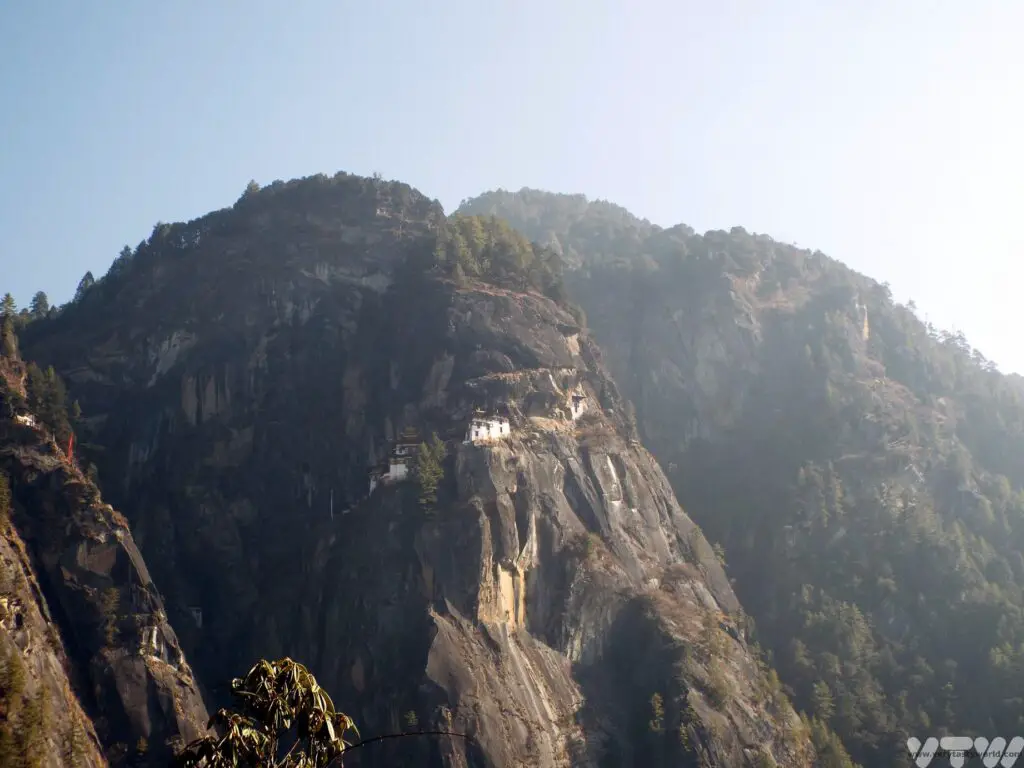
Continue To The Viewpoint
Continuing the trek you climb higher and higher until you reach the splendid viewpoint, an essential photo stop which offers your first close-up glimpse of the monastery buildings. It’s at approximately the same elevation as the Tiger’s Nest but it is located across the valley which needs to be traversed.
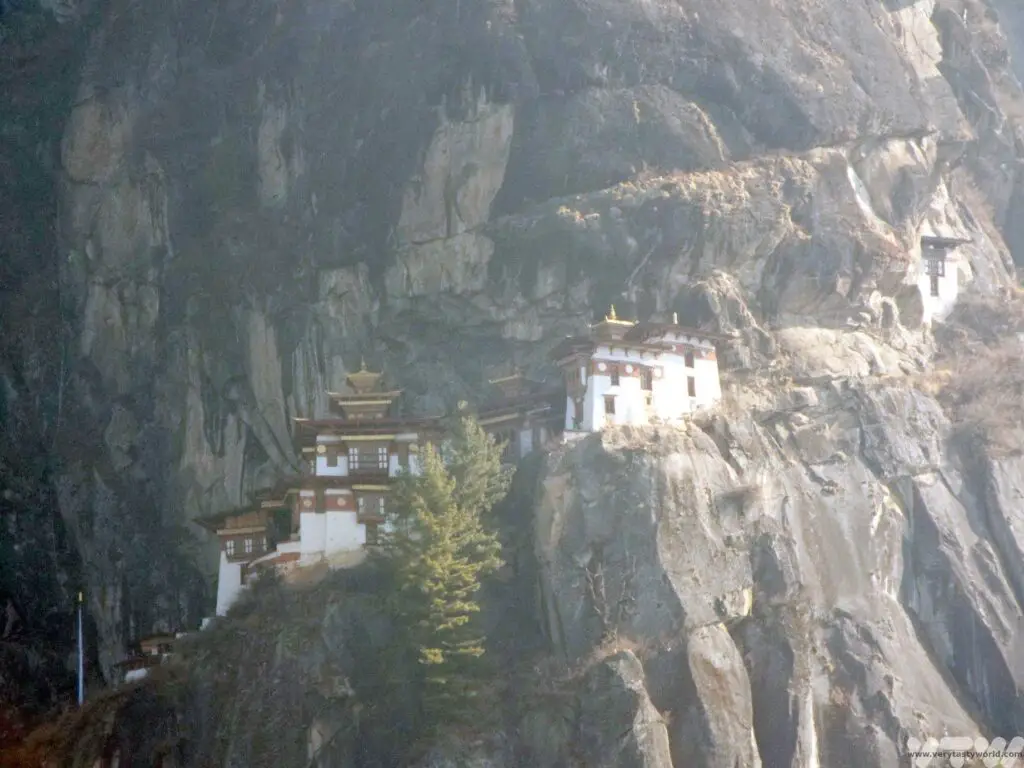
The Final Stretch (aka the Tricky Bit)
When you reach the viewpoint you think you are almost there but the most difficult part of the trek is yet to come. You need to cross the valley to reach the monastery on the other side. You descend slightly along the cliff path, which is easy enough.
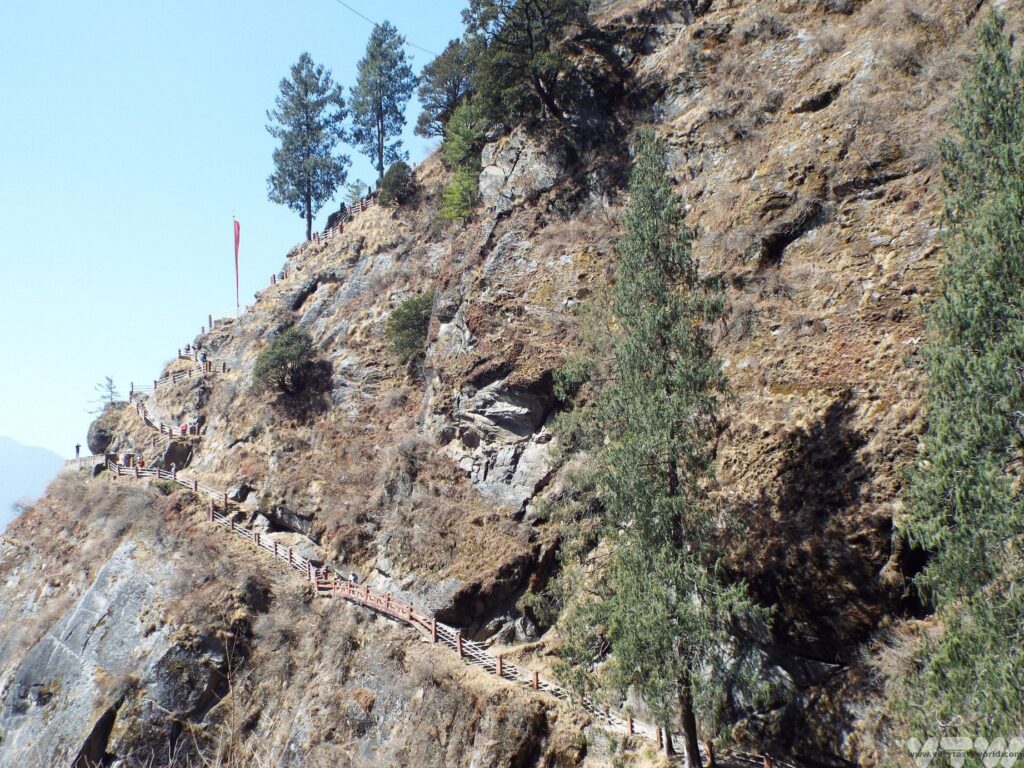
But then need to cross a narrow section with a waterfall on the cliff-side in order to reach the next mountainside. It’s not hugely difficult but can be a little slippery and isn’t ideal if you’re not keen on heights as there’s a fair old drop to the valley below.
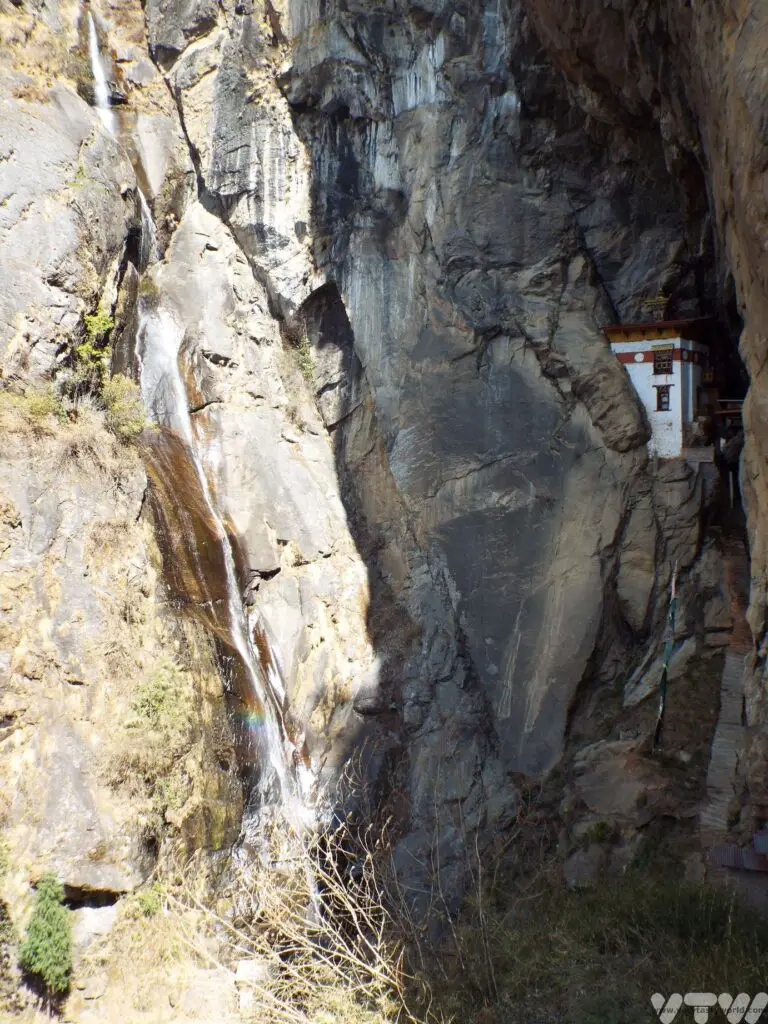
Then it’s a walk up the other side, largely on steps, to the monastery itself.
Entering the Monastery
Once you have reached the monastery entrance you might think you have reached the top. But there are a lot of stairs inside the monastery itself. We trekked up alongside a random fellow traveller who made it to the entrance but was just too tired to explore it! So save a bit of stamina. Shoes must be removed in order to visit the various rooms within the temple.
This is a working monastery so photography is not allowed. The temple is comprised of four main buildings. Padmasmabhava’s cave – the first one he entered riding the tiger, is called Tholu Phuk and the cave where he meditated is Pel Phuk. Steps have been cut into the rock and there are bridges to cross in order to reach particular rooms.
Bhutan Tiger’s Nest Trek – The Route Down
You return via the exact same route. While the upward journey is hard on your lungs, the downward journey is hard on the knees. Again, although the descent will be quicker, take it easy and don’t rush.
Information About The Hike
When Is The Best Time to Attempt the Hike?
We visited Bhutan in March which was the low season. As it was early spring the weather was a little chilly at times but that was absolutely perfect for walking in. It also meant that the route was less crowded than in the high season (April, May and September to November). It is possible to visit Tiger’s Nest all year round but beware that the monsoon arrives in Bhutan during the summer so trekking wouldn’t be much fun. And we wouldn’t want to attempt the waterfall crossing section on a slippery path in the rain.
Do You Need to Be Fit?
The walk should be fine for anyone of average fitness. The total distance covered is around 6km. The most challenging element is that you are trekking at altitude – the hike will take you to over 3000m above sea level – and this could well knock the breath out of you. There is a lot less oxygen available at these dizzying heights. The elevation gained is around 500m from the car park to the monastery. Some people do struggle with the altitude and acute mountain sickness is a serious condition. Follow your guide’s instructions and do let them know if you are feeling unwell.
We actually did our trek at the end of our trip to Bhutan. The country has the world’s highest average elevation, although for most of our trip we had been exploring the country at around 2000m above sea level. Waiting until the end of the visit meant that we had a week or so to acclimatise to being at altitude.
What Clothing Should You Wear?
As with all temples in Bhutan modest dress is required to enter the monastery and this includes long-sleeved tops to cover your entire arms. You might want to hike in a t-shirt if the weather is warm but remember to take a light jacket if you want to visit the monastery itself. Long trousers should be worn.
What Should I Bring?
We recommend wearing comfortable clothes and good walking boots or shoes for the hike. Consider wearing footwear with ankle support as you will be walking on an incline for pretty much the entire trek. It’s also worth minimising the equipment you take with you so that you aren’t carrying too much. We did the hike simply taking a day-pack containing water bottles and camera.
How Long Does the Hike Take?
The time varies depending on how fit you are and how you get on walking at altitude. There is no pressure to rush and it isn’t a race, so we advise taking the walk easy. If you need to catch your breath, stop and catch your breath. Some people take three hours, others take eight. We took five hours for the total trip which included the visit to the monastery and a buffet lunch at the resting place while chatting with some very nice visitors from Japan.
Other Places to Visit in Paro
Located in Paro valley, Kyichu Lhakhang is one of Bhutan’s oldest monasteries. Legend tells that it was one of 108 temples constructed on the same day by the Tibetan King Songtsen Gampo, to subdue Sin Mo, a feared demoness.
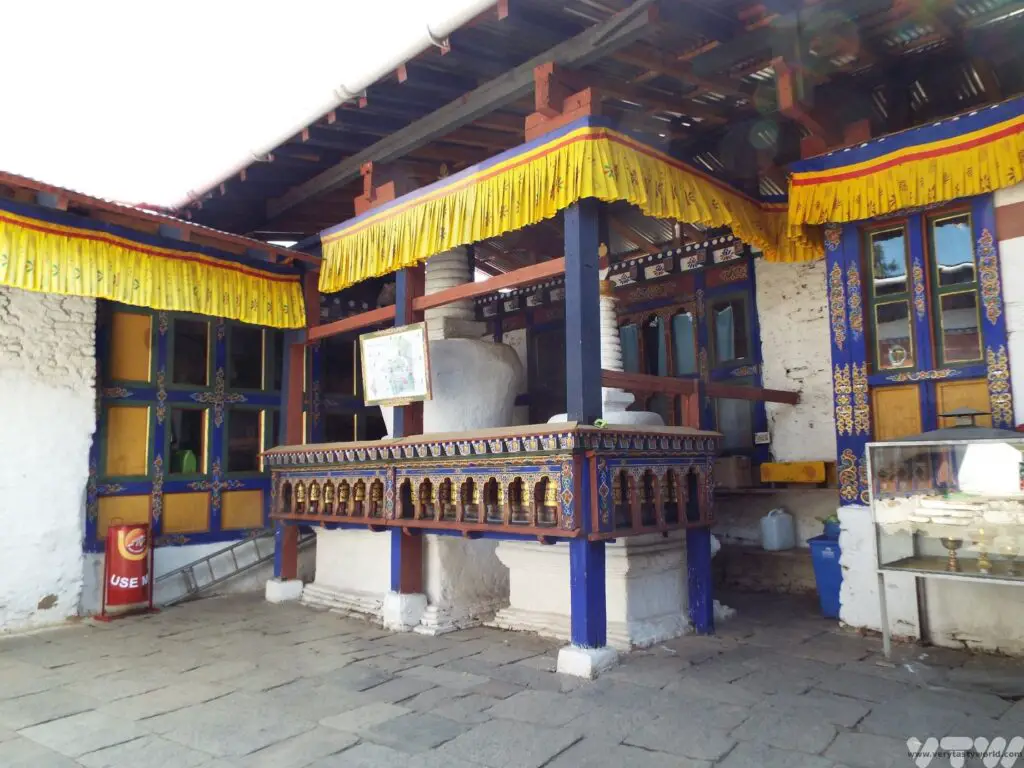
It has two orange trees in the courtyard and they are purported to bear fruit at all times of the year. There were certainly plenty of oranges on the trees when we visited.
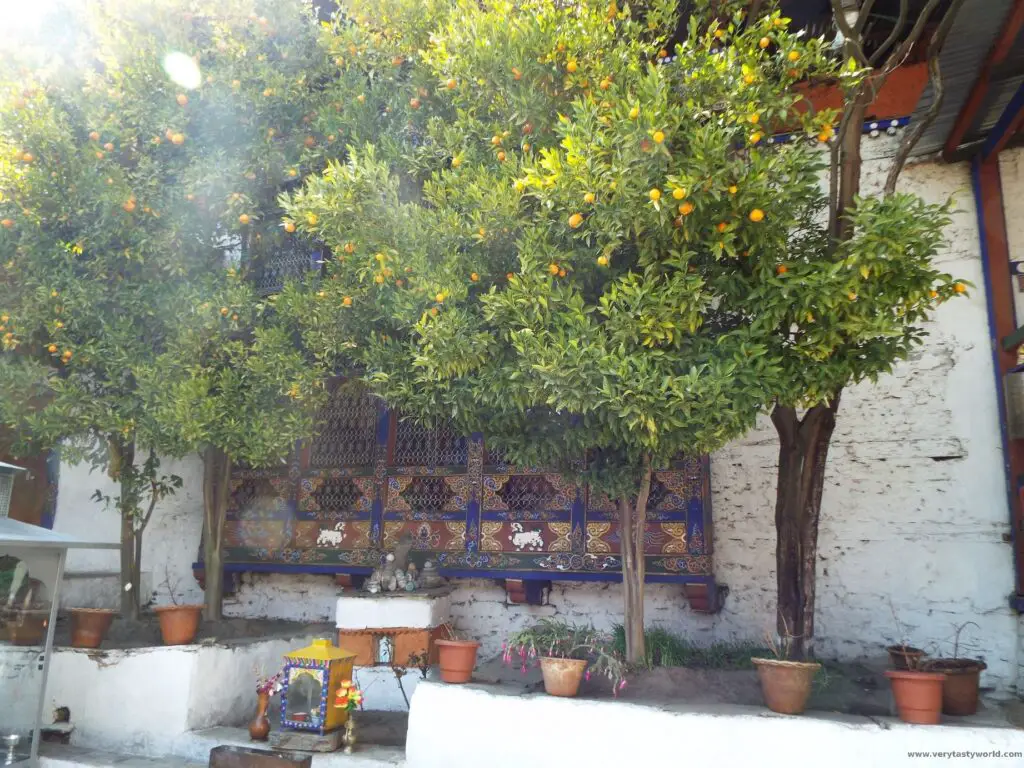
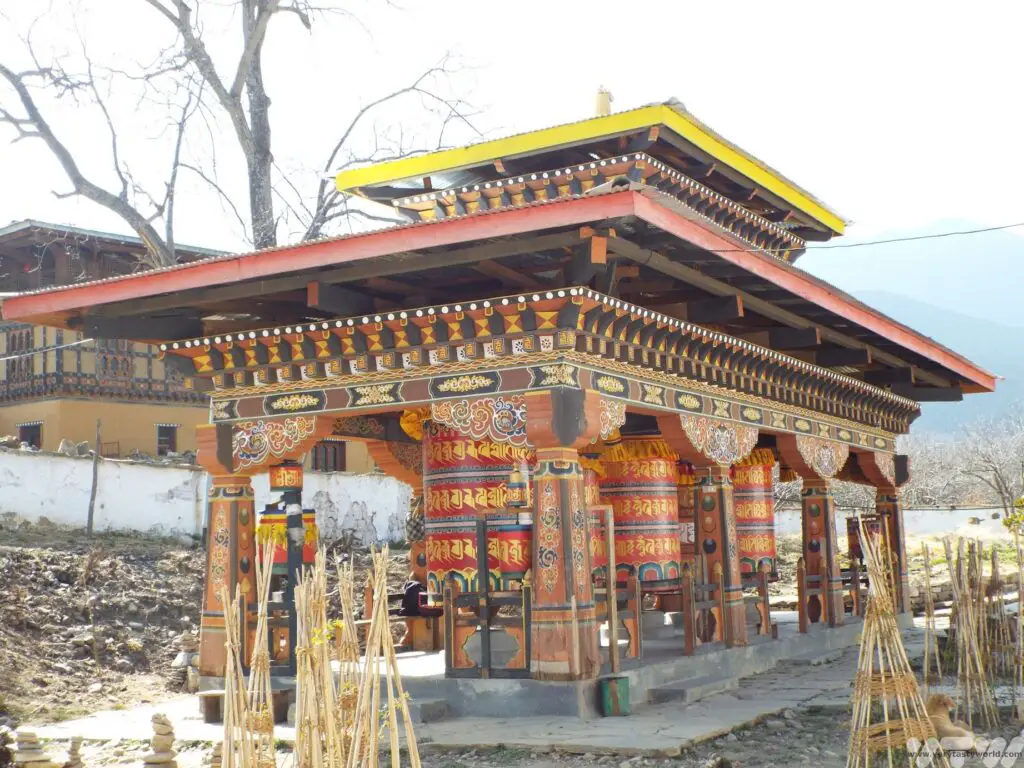
We also enjoyed trying our hands at archery, Bhutan’s national sport. There are practice ranges all over the country and it’s fine to show up and have a go. We had watched a remarkable archery tournament a few days previously – where local archers would compete to hit a tiny target from an incredible distance.
Well, it was great fun but we were fairly useless. Mitch’s first arrow flew over the fence and into the car park – fortunately, there was no one there!
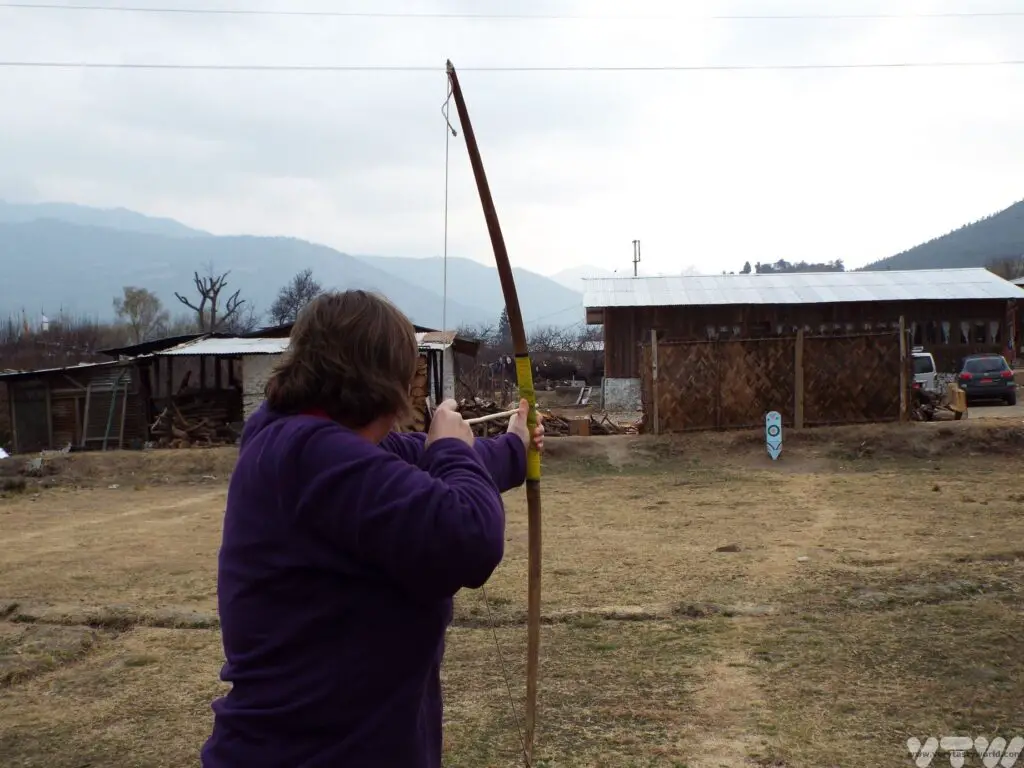
Colin did, however, eventually manage to hit the target!
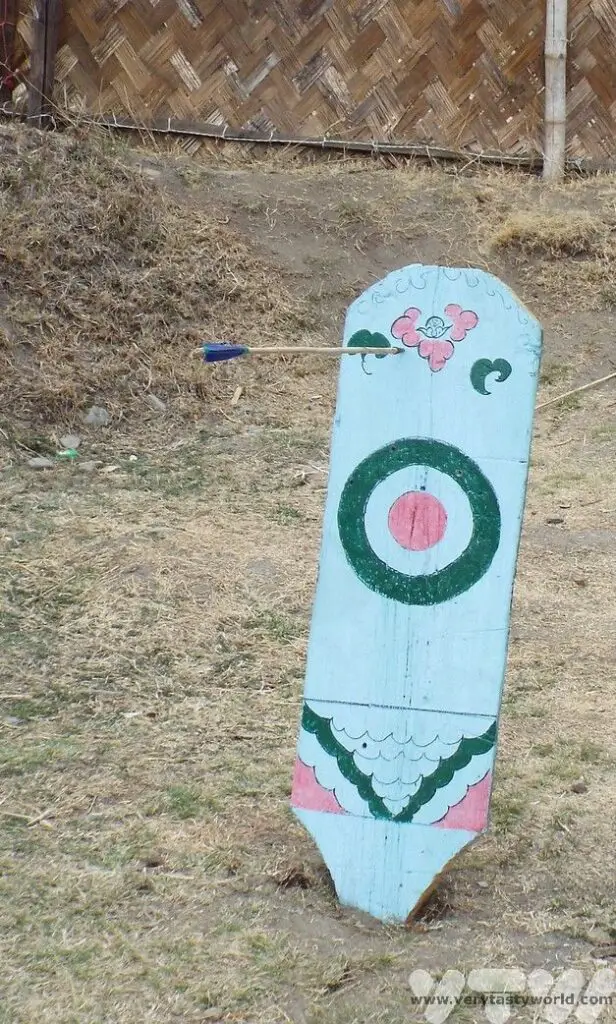
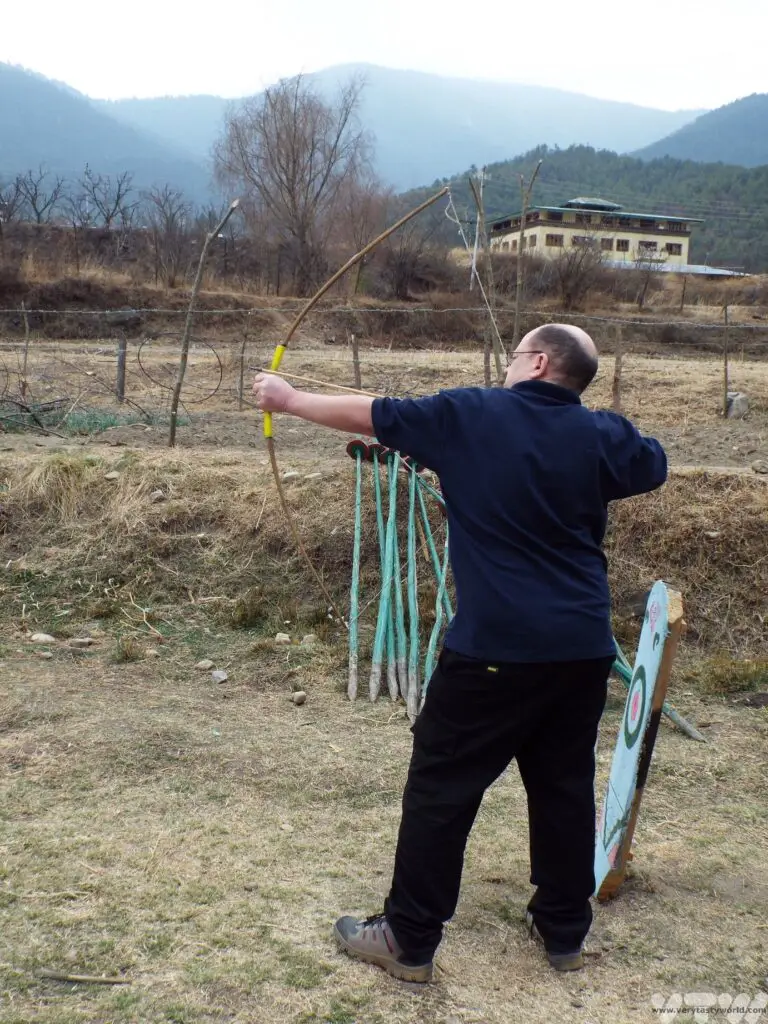
As with all things in Bhutan, if you want to try a particular activity or visit a particular site, ask your guide and they should be able to arrange it.
We stayed at the Metta Resort on the outskirts of Paro. It was a nice enough place but we found that the food was largely aimed at tourists – both Eastern and Western. We asked our guide whether we could eat at a local restaurant instead of at the hotel, so he took us to a fabulous farmhouse in the evening and we enjoyed traditional Bhutanese fare washed down with ara, an alcoholic drink made from fermented grains.
Essential Information About Visiting Bhutan
The Bhutanese government sets a daily tariff for visitors. When we visited this was $200 per day (low season) which included the costs for our delightful guide and driver, as well as all accommodation, food and entrance to the dzongs and museums. This cost included $65 for a sustainable development fee which went directly to supporting local people. So entrance to the Tiger’s Nest, and all other monasteries/dzongs, was included.
In 2022 Bhutan significantly increased the daily tariff from very expensive to even more expensive by increasing the sustainable development fee to an eye-watering $200 per day (on top of other costs). This resulted in a significant drop in visitor numbers, so the system changed again in 2023. The sustainable development fee has been halved to $100 per day (which is still expensive and doesn’t include accommodation and transportation etc) for the next four years (as at September 2023). So, if you’re planning to visit, it’s worth considering making the journey sooner rather than later. Bhutan is expensive to visit but we feel very much that our time spent in this remarkable kingdom was absolutely worth it.
Related Posts You May Enjoy

- A One Day Hanoi Itinerary
- Mekong Meanderings
- A Chiang Rai Temple and A Country Retreat
- A Chiang Mai Tour in Northern Thailand
- Sunrise at Angkor Wat and Other Temples
- Mekong Delta River Cruise in Vietnam

